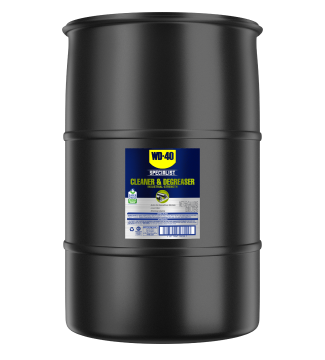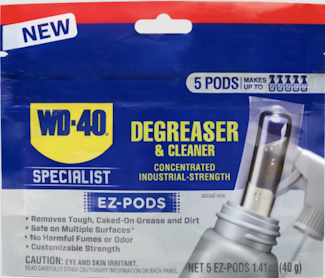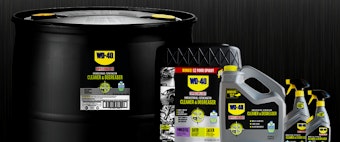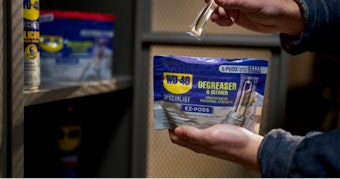Exploring the Versatility of Commercial Degreasers
Exploring the Versatility of Commercial Degreasers
<< BackToday’s industrial landscape necessitates fast action, especially when maintaining your equipment. Maintaining cleanliness and efficiency in industrial operations is crucial and the right commercial degreaser can make a significant difference in ensuring equipment runs smoothly and safely. In the piece below we explore the versatility of commercial degreasers, highlight the best practices to follow, and investigate their applications across various industries. Whether you're in manufacturing, food and beverage, healthcare, or any other sector, implementing the right degreaser for your needs is essential.
Understanding Commercial Degreasers
A heavy-duty degreaser is a type of cleaner specifically formulated to remove grease, oils and grime. The purpose of a cleaner and degreaser, as its name implies, is to remove contaminants like grease and oil. These contaminants are a common occurrence in commercial manufacturing or assembly operations.
Key Ingredients and Their Functions
The majority of greases are derived from petroleum products and are identifiable by their use of fluorocarbons. Other sources of grease include organic ones such as those you might find in a food processing plant. In general, petroleum-based products are suitable commercial degreasers for a range of synthetic lubricants while aqueous and alcohol-based degreasers might be more suitable for dissolving organic contaminants.
Considerations for Application
The main considerations to take when implementing commercial degreasers are to establish what the contaminant is and the surface that needs to be cleaned. Before applying a new heavy-duty degreaser to a situation, it’s best to test a small sample. Some surfaces, especially plastics, may dissolve when used with certain commercial degreasers. Oftentimes the degreasing product will be formulated for a specific type of grease and sold under a name that indicates where it is supposed to be used, like a glass cleaner, or stainless steel degreaser for example.
Environmental and Safety Concerns
There has been a lot of scrutiny over the years when evaluating solvent-based (fluorocarbons) versus aqueous (water-based) degreasers. There are a number of regulatory agencies which preside over various degreasers. In general, aqueous formulations are less problematic when it comes to environmental concerns and the use of known carcinogens. However, there is usually something of a trade-off between environmental friendliness and performance capabilities.
Aqueous solutions usually operate over a narrower temperature range: roughly room temperature up to about 176˚F. They are usually completely wiped off rather than left to sit on the surface to evaporate. Fluorocarbons unlike aqueous formulations, are often more volatile and can be used up to temperatures as high as 392˚F. Since they are not water-based, some formulations can be used down to 32˚F. In addition, due to the surface tension of water, aqueous cleaners and degreasers usually cannot penetrate as well as solvent-based solutions.
Ensure your industrial cleaning meets the highest safety standards. Explore our range of safe and effective commercial degreasers today!
Benefits of Using Commercial Degreasers
The good news is that no matter what your heavy-duty degreasing requirements are, there is likely a product or combination of products already on the market that can do the job. Whereas it used to be a matter of grabbing some soap powder and a scrub brush to handle messy clean-up jobs, today’s technology allows for an approach that is quicker and more effective than ever.
Efficiency and Effectiveness
Commercial degreasers offer much better efficiency and effectiveness compared to household degreasers. This is because they are specifically formulated to tackle heavy-duty tasks quickly and thoroughly.
Commercial degreasers contain powerful active ingredients like non-ionic surfactants, which can bind to oil and grease, and chelating agents, which isolate metal ions and prevent them from interfering with the degreasing process. These ingredients ensure that the commercial degreasers are more effective at breaking down grease and grime. This leads to faster maintenance activities, which in turn reduces equipment downtime and allows operations to resume more quickly.
The superior performance also translates into monetary savings in industrial environments, as less of the degreaser is required to clean equipment and surfaces.
Save Operational Costs
Implementing a commercial degreaser not only results in faster cleaning times but also produces a better-finished product with less waste. An effective commercial degreaser means a more uniform product at a lower operational cost.
The higher efficiency and effectiveness offered by commercial degreasers lead to improved operational efficiency, less labor costs associated with degreasing and a safer and cleaner work environment.
Expand your cleaning capabilities and enhance environmental sustainability. Explore our innovative cleaning solutions today!
Choosing the Right Degreaser for Your Needs
Factors to Consider
When introducing a new cleaner and degreaser, it is important to know the formulation of the contaminant that you would like to remove along with the characteristics of the substrate that it is adhering to. You may need to rule out certain formulations right away. As an example, certain plastics cannot stand up to acetone. Even though it is cheap, it is flammable and is an aggressive solvent that dissolves many plastics. The best place to start is to take what you know about the materials involved and then go talk to an expert to see if there are known good combinations that are similar to your needs. Assuming the manufacturer has a test lab, you can work with them and some sample pieces to see what works best.
Safety Factor
One thing to consider is that just about any chemical formulation will have a Material Data Safety Sheet (MSDS). This document will provide a wealth of information: Safety protocol, first aid, storage and disposal requirements, proper safety gear, and other regulations. Part of specifying and using a commercial degreaser is knowing all the peripheral requirements that come along with using it.
WD-40 Specialist® Degreasers
WD-40® Brand has worked out the particular needs for degreasing applications in the industrial space. The formulations made available in our WD-40 Specialist® collection take into account the most common surfaces and the most common contaminants found on those surfaces. These are just a few of our top recommended degreasers.
- WD-40 Specialist® Cleaner and Degreaser EZ-Pods: Greasy wheels, gears, floors, and surfaces, including concrete and stainless steel. Dissolve one pod in 32 ounces of water (add an extra pod for a stronger concentration). Pods allow you to customize the concentration for your application. Put the mixture in a trigger spray bottle for application. Spray and let sit for about a minute then rinse/wipe off with water. It works on machinery, commercial kitchens and sensitive surfaces like rubber and neoprene
- WD-40 Specialist® Machine & Engine Degreaser: This product is a low-residue water-based formula with foaming action that penetrates for completely clean results. Equipped with a nozzle capable of spraying up to 5 feet, it quickly removes grease, oil, dirt, grime, tar, adhesives, and more without engine disassembly. It is ideal for auto & truck engines, tractors, forklifts, gears & chains, industrial machinery, farm equipment, and other metal tools.
The above list is not a comprehensive one, but it should help give you an idea of what sorts of commercial degreaser solutions are available off-the-shelf.
Find the ideal commercial degreaser for your specific needs. Shop our wide range of products now!
FEATURED PRODUCTS
WANT TO GET MORE TIPS AND TRICKS?
SUBSCRIBE TO THE NEWSLETTER



